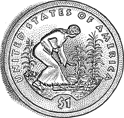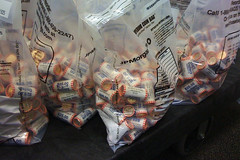
PREV ARTICLE
NEXT ARTICLE
FULL ISSUE
PREV FULL ISSUE
WALL STREET JOURNAL REPORTS U.S. MINT CREDIT CARD REWARD SCAM
Tim L. Shuck of Ames, IA was the first of several E-Sylum readers who forwarded this article from Monday's Wall Street Journal.
-Editor
At least several hundred mile-junkies discovered that a free shipping offer on presidential and Native American $1 coins, sold at face value by the U.S. Mint, amounted to printing free frequent-flier miles. Mileage lovers ordered more than $1 million in coins until the Mint started identifying them and cutting them off. Coin buyers charged the purchases, sold in boxes of 250 coins, to a credit card that offers frequent-flier mile awards, then took the shipments straight to the bank. They then used the coins they deposited to pay their credit-card bills. Their only cost: the car trip to make the deposit. Richard Baum, a software-company consultant who lives in New Jersey, ordered 15,000 coins. "I never unrolled them," he says. "The UPS guy put them directly in my trunk." Patricia Hansen, a San Diego retiree who loves to travel, ordered $10,000 in coins from the Mint. "My husband took them to the bank," Ms. Hansen says, and she earned 10,000 miles toward free or upgraded travel. Even with all the offers that are available, the deal the Mint offers -- free miles without spending any dollars -- is unique. The Mint says the dollar-coin free-shipping offer began in June 2008. About $130 million in coins have been issued to 40,000 buyers, mostly coin collectors, community banks and small businesses such as vending-machine companies and car washes.
In late August and September, officials noticed a sharp uptick in "large repetitive orders" from a group of individuals, Mint spokesman Tom Jurkowsky says. At about the same time, the Mint received reports from banks around the country that coins were being deposited that were still in their U.S. Mint boxes, he says. Officials found Internet chat rooms where the coins-for-miles scheme was detailed. Letters were sent to customers asking whether their intended use complied with the program's purpose. Customers who didn't respond were blocked from the program, Mr. Jurkowsky says. Fewer than 400 buyers were blocked, he says. "Is this illegal? No. Is it the right thing to do? No, it's not what the program is intended to do," Mr. Jurkowsky says.
To read the complete article, see:
Miles for Nothing: How the Government Helped Frequent Fliers Make a Mint
(online.wsj.com/article/SB126014168569179245.html)
The Numismatic Bibliomania Society is a non-profit organization promoting numismatic literature. See our web site at coinbooks.org. To submit items for publication in The E-Sylum, write to the Editor at this address: whomren@gmail.com To subscribe go to: https://my.binhost.com/lists/listinfo/esylum All Rights Reserved. NBS Home Page Contact the NBS webmaster 
|
 Enthusiasts of frequent-flier mileage have all kinds of crazy strategies for racking up credits, but few have been as quick and easy as turning coins into miles.
Enthusiasts of frequent-flier mileage have all kinds of crazy strategies for racking up credits, but few have been as quick and easy as turning coins into miles.
